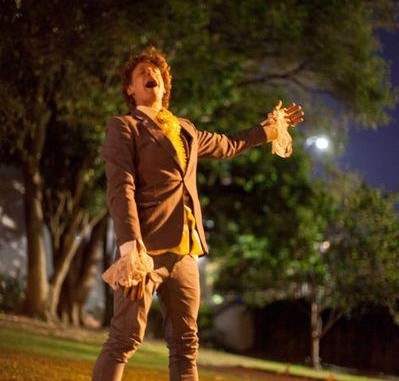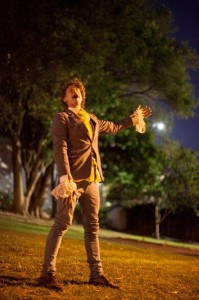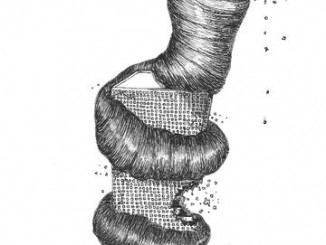
Anarchic Fairy Tales in the Dark [by James Wenley]

At the same time as the Lantern Festival lit up Albert Park, Myers Park came to life in quite a different way as a procession of Fairytale characters and creatures prowled its grounds. Myers Park has been associated with Auckland Fringe since the Festival’s original launch in 2009 and has played a part in reclaiming the park – often avoided – for the public. Inheriting the Myers Park mantle from 2011’s When Animals Dream of Sheep, Celery Productions’ Ella Mizrahi and Celia Harrison (the brains behind Ponsonby Park’s popular Art in the Dark) have teamed with collaborators from The Basement theatre to produce promenade theatre Celery Stories which is at times magical, gleeful, anarchic, and frustrating.
We gather at the St Kevin’s Arcade entrance to Myers Park where we are hepfully sprayed for the “giant” mosquitoes that lurk below. After a wait, Bruce Hopkins, wearing a muscle-chest suit, announces himself. He reads us a ‘Once upon a time’ story about a “merry band of travelers” who ventured into a strange world (that at times felt like they had partaken of the “electric pooha”) and faced encounters with characters like a lone and mischievous piper, seven short and hairy men, and a red-hooded “waif”. We would of course meet them all – and more – in our own journey through Myers Park to The Basement Theatre, and this time-honoured story device is a welcome way of putting what we are about to see in some sort of context. Hopkins warns that “survival is the order of the night” before shouting for us to “make haste” as we go down the arcade stairs. Our first encounter is a portent of doom: a maniacal face projected onto a large tree, moving as if the tree’s leaves itself were in motion; there are cries of recognition and surprise as audiences sight the face. It pays to keep your eyes open on this adventure.
The fairytale motif is particularly suited to Myers Park, which seems other-worldly at night, and the parks’ various nooks, crannies, buildings and playground are cleverly utilised as we encounter different scenes from the Brothers Grimm playbook and beyond. Fairytales are a clever choice too as accessible cultural foundation myths. Why do these stories continue to appeal to the childhood imagination? As stories they seem to touch something quite deep-seated within us. Celery Stories takes a Once Upon a Time / Grimm approach with a contemporary and sometimes ironic spin on the stories that invites us to consider them with fresh eyes. The Hans Christian Andersen story of the Emperor’s New Clothes sees Dan Vient’s Emperor gaily giving us a fashion show of his fine new silks – a strategically placed banner only covering the Emperor’s jewels for some of the audience – and we catch the situation’s absurdity. Red Riding Hood’s (Julia Croft) encounter with the grandmother-posing wolf emphasises the violence of the story as Hood emerges following horrific noises with blood dripping down her face. The seven dwarves, taking the Disney attributes, become high-vis workers in the park who don’t do particularly much work. The shallow romanticism of a singing Prince’s (Jordan Mooney) search for his sleeping beauty (Chelsea McEwan Millar) is counterpointed when, upon waking, the two transform into a drunk and warring couple that might have wandered into Myers Park. A happy ending is returned when they begin to ballroom dance, and the audience is invited to join in. Red Riding Hood, who I discover has a german accent, takes me for a whirl, and I congratulate her on how she took down the wolf.
As part of the collective audience, it is hard to know what is expected of us, or where we need to go and when. Celery Stories doesn’t seem to have made up its mind if it a series of art-meets theatre installation pieces ala Art in the Dark, which the audience seeks on their own terms, or whether there is a continuing narrative which the entire audience gets to experience at the same time. As it was, the evening began to display a very anarchic spirit indeed, the actors improvising madly to keep some semblance of control. The simple moments of encounter worked beautifully: a Princess (Annabelle Harrison) dancing delicately on a series of upside down tea-cups, or the spellbinding charm of the Little Mermaid (Colleen Davis) singing on a rock as bubbles floated around here. Other times I felt I was missing out; in the wrong place at the wrong time. While most of us watched Harrison, further down the park a scene had started with Rapunzel and Ash Jones’ strange German character that had all but finished when I arrived. Similarly, I missed most of Harry McNaughton’s wolf shtick with the three little pigs, as well as Josephine Stewart’s witch, although I did get to sample the delicious cooked childrens’ ribs that she offered. Not enough care and thought was taken into the needs of the audience.. We either needed to be encouraged to take each scene at our own pace, in which event they should then repeat for the next viewers, or we needed to be more effectively corralled to go to where the next story was taking place.
Many times it seemed like things were happening for the sake of happening, rather than the disparate threads and ideas being weaved into a coherent and compelling vision. Why was Bruce Hopkins wearing that muscle suit anyway? For what purpose were the audience given an unappetising ‘survival kit’ with a piece of candy pressed into a piece of bread and a few peas? Who exactly was Ash Jones character and what was his purpose beyond comic relief? [Theatreview’s Nik Smythe reckoned he was Hansel. Based on the story at the beginning and his prop of an air-piano, I took him to be the piper – if so, a plot element poorly utilised]. Celery Stories fell victim to a concentration on the individual performance pieces at the expense of a satisfying total experience.
There was one other event that troubled me: early in the evening a performer approached one of two friends who had joined me for the show, asked her age, and then told her to come with him. We didn’t see her for the rest of the performance. While we continued to take in the stories of Myers Park, she was taken by taxi to The Basement where she was invited to a Mad Hatters tea party to welcome everyone else when we finally arrived at The Basement. While this is an attempt to offer an alternative experience, it does cheat these few audience members from the experience that they had actually paid for (to be more precise, I had bought my friend the ticket, so felt a little cheated myself!).
We reunite at The Basement where we climb through a bouncy castle to get to the bar. More than anything else we had just seen, the bouncy castle got us in touch with a fairytale childlike exuberance as we bounced. The Basement was full, and alive, and Celery Stories was a great shot in the arm for the Fringe Festival by getting a large group of Fringe fans together at The Basement hub. It is mooted that a Celery Stories type show could become an annual Auckland event, the theatrical equivalent of Art in the Dark. There is enough promise and ingenuity displayed in Celery Stories to be confident that their dream of getting people out of the theatre and into the streets is worthy of pursuit. More please.
Celery Stories played as part of Auckland Fringe on the 22nd and 23rd Feburary 2013.
SEE ALSO: Theatreview.org.nz review by Nik Smythe




Leave a Reply